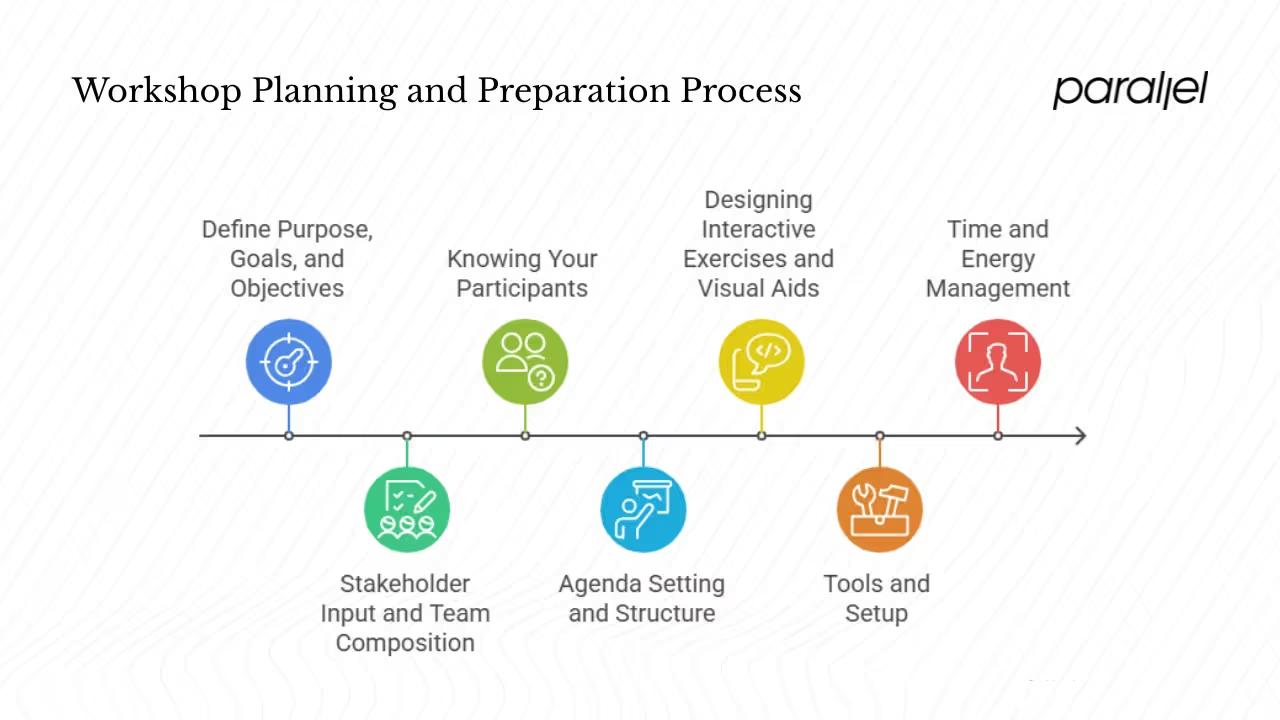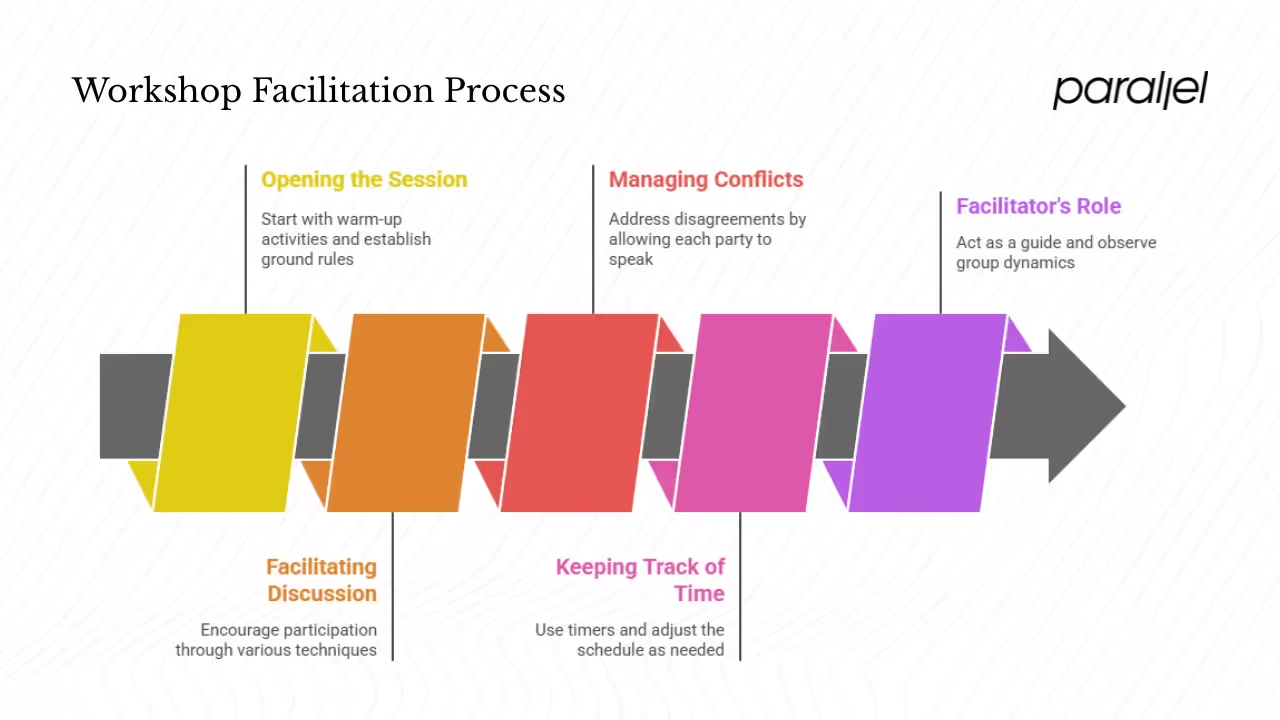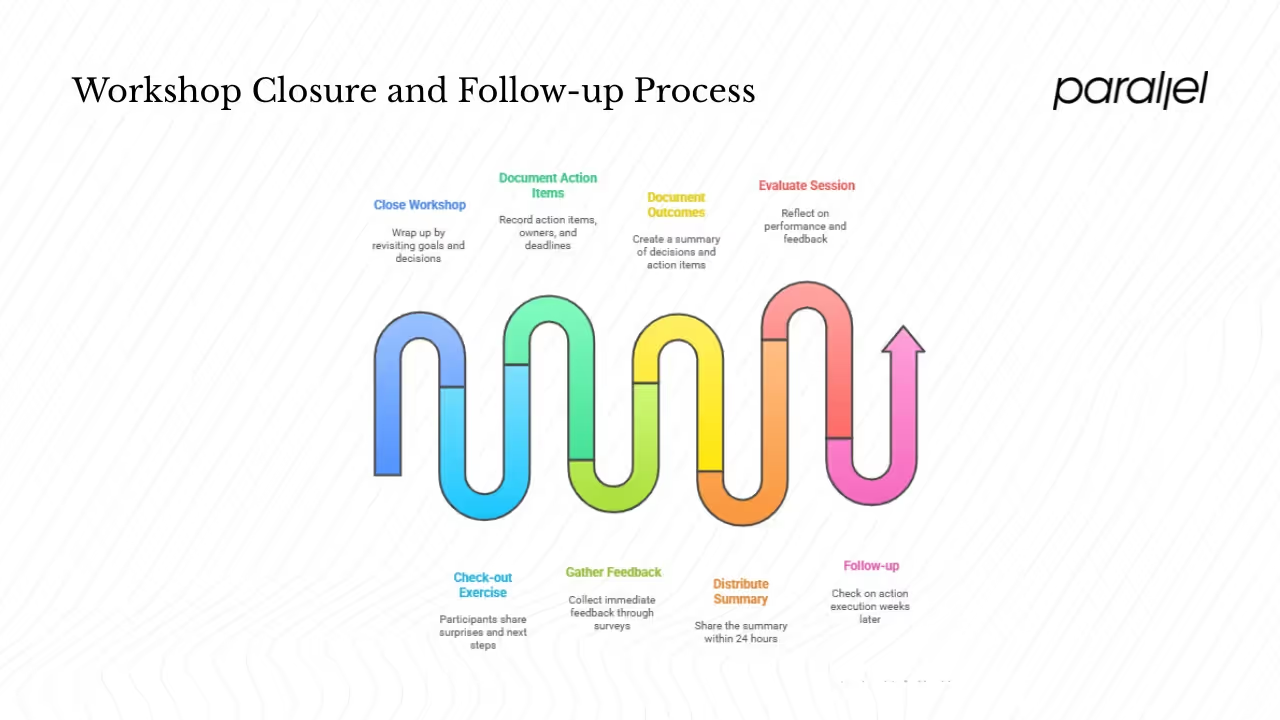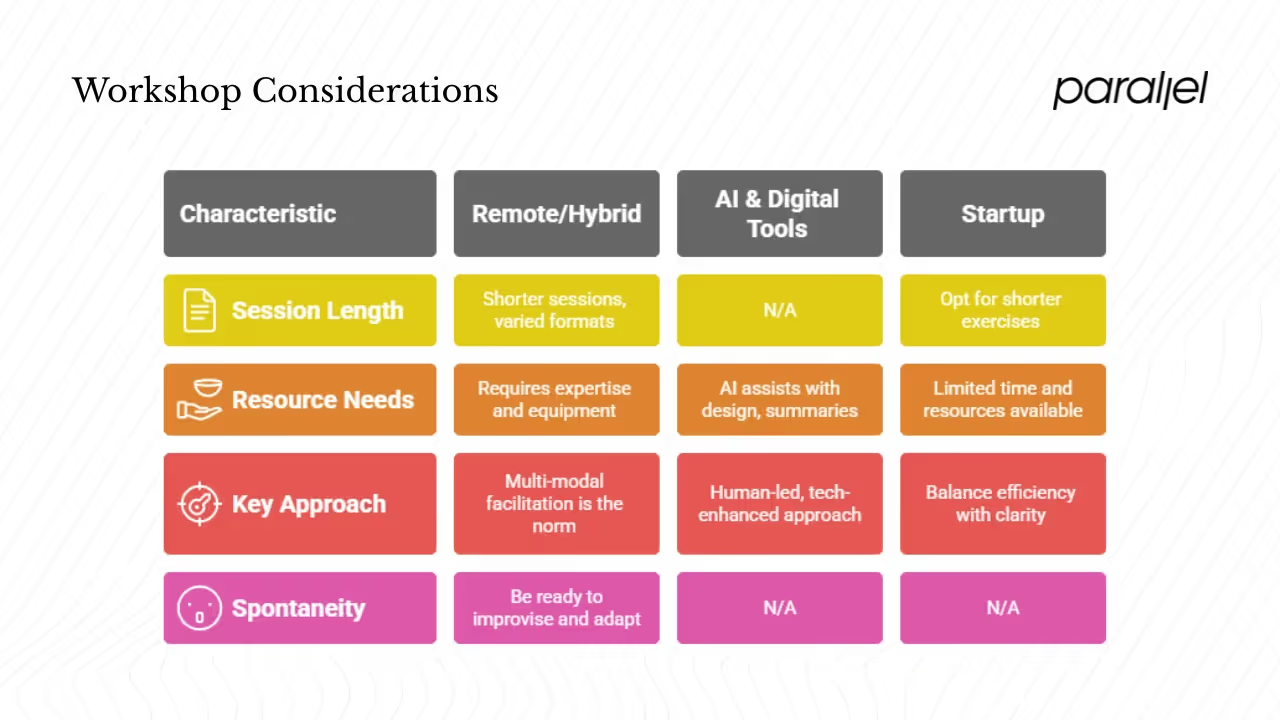How to Facilitate a Workshop: Guide (2026)
Discover techniques to facilitate effective workshops, including planning, engaging participants, and achieving outcomes.

Running a workshop inside a young startup is one of the fastest ways to align founders and teams, build shared understanding and unblock decision‑making. Startups survive by learning and adapting quickly. A well‑facilitated workshop brings the right people together, surfaces hidden assumptions and accelerates decisions. In this article I’ll show you how to facilitate a workshop effectively. I’ll define facilitation, share the steps to prepare, run and follow up on a session, and offer a cheat sheet of tools and exercises. By the end, you’ll walk away with practical skills and a mindset tuned to the needs of early‑stage AI/SaaS teams.
Quick‑Start Guide: How to Facilitate a Workshop
Use this checklist as a one‑page reference for running effective workshops—especially in fast‑moving startup or AI/SaaS contexts:
- Define the purpose and measurable success criteria
- Invite the right participants—cross-functional, empowered decision-makers
- Design the agenda—balanced activities, breaks, clear outcomes
- Prepare materials & tools—in-person or remote/hybrid ready
- Facilitate engagement—stay neutral, manage time, ensure participation
- Capture decisions & assign actions during the session
- Follow up—document outcomes, share summaries, gather feedback
- Evaluate & improve—reflect, adapt, iterate
Workshop fundamentals: purpose and facilitator skills
Facilitation isn’t lecturing or commanding a meeting—it’s guiding a group through structured activities so they can discover answers themselves. Workshoppers AJ & Smart describe facilitation as “guiding the group through collecting relevant information, identifying underlying challenges, ideating possible solutions, and helping the team define and commit to the next steps”. Presentations and directives play a role, but they aren’t the heart of a workshop.
Why goal alignment matters
In startups, misaligned goals waste precious runway. Founders, product managers, designers and engineers must agree on why the workshop exists and what outcomes matter. When we’ve skipped this step, sessions drift, decisions are revisited and momentum stalls. Howspace’s facilitation guide notes that clear objectives and a shared understanding of success allow teams to assess whether the session delivered value.
What facilitation isn’t
A facilitator doesn’t impose solutions or push personal preferences. The Agile Business Consortium describes a workshop as a neutral environment where participants are specifically chosen and empowered to deliver outcomes. The facilitator has no stake in the content and focuses on enabling collaboration. This neutrality helps teams avoid groupthink and ensures decisions belong to those who will execute them.
Core facilitator skills
Startups often confuse charisma with facilitation. In my experience, great facilitators share a few traits:
- Effective communication: Clear instructions, active listening and non‑verbal awareness.
- Unbiased perspective: AJ & Smart emphasise that a facilitator must avoid driving toward a preplanned conclusion.
- Time awareness: Knowing when to pivot or cut discussions and managing energy.
- Problem‑solving tool kit: Having varied activities for ideation, prioritisation, mapping and decision‑making.
- Conflict resolution: Creating psychological safety and mediating disagreements.
- Neutral stance: Remember you’re the guide, not the hero.
Planning and preparation: designing your session

1) Define purpose, goals and objectives
Every workshop starts with a “why.” What business goal, product problem or design decision needs resolution? Invite key stakeholders to co‑define the purpose and expected outcomes. Howspace’s guide suggests turning the purpose into a measurable goal—something the group can track and agree upon afterwards. It doesn’t have to be numeric; it just needs to be testable: for example, “Align on our onboarding flow and agree on next three experiments.”
2) Stakeholder input and team composition
Invite only those who can contribute expertise or make decisions. Agile Business explains that participants should be chosen and empowered to deliver the required outcome. Aim for a cross‑functional mix—product, design, engineering, marketing—so decisions won’t be revisited later. When we’ve run AI product workshops with just founders and designers, we often discovered missing technical realities.
3) Knowing your participants
Map out who’s attending, their domain knowledge and expectations. Are there power dynamics? Does everyone understand the context? Pre‑workshop questionnaires help uncover prior knowledge and concerns. This preparation allows you to tailor activities and avoid surprises.
4) Agenda setting and structure
Good agendas balance focus and flexibility. Time‑box every item and include buffer time and energisers. A typical structure for how to facilitate a workshop is:
- Icebreaker/check‑in – build trust and psychological safety.
- Purpose and ground rules – clarify goals, expectations and behavioural norms.
- Main activities – ideation, prioritisation, mapping or decision‑making exercises.
- Breaks and energisers – manage cognitive load.
- Wrap‑up – agree on decisions, actions and owners.
Use a mix of individual and group exercises (brainstorming, silent sketching, affinity mapping, dot‑voting, user journey mapping). Visual aids such as whiteboards, flipcharts, sticky notes or virtual tools help make ideas visible.
5) Designing interactive exercises and visual aids
Choose exercises that fit your objective. For problem definition, use “How Might We” statements or Stinky Fish sessions to surface fears and assumptions. For ideation, apply Crazy 8s or brainwriting (silent idea generation to prevent groupthink). For decision‑making, try dot‑voting, Priority Matrix or Now‑Next‑Later roadmaps. In remote settings, tools like Miro, Mural or FigJam replicate physical whiteboards.
6) Tools and setup (in‑person vs. remote)
Book venues and materials early. For in‑person sessions, ensure adequate space, whiteboards, sticky notes and snacks. For remote or hybrid workshops, test video conferencing, digital boards, breakout rooms and collaborative documents. SessionLab’s 2024 report notes that digital tools are transforming facilitation and making sessions more interactive.
7) Time and energy management
Time is finite, and energy even more so. Workshopper’s experts advise facilitators to “treat energy like a delicate, finite resource”. Plan breaks strategically (e.g., after lunch slump) and insert energisers or relaxed activities to maintain attention. Working with a co‑facilitator can help maintain your own stamina.
In our AI onboarding sessions, we’ve noticed that 90‑minute modules with short breaks yield more focus than half‑day marathons. The 2025 State of Facilitation report confirms this trend: the typical session length has shortened from half a day to 90 minutes. This shift reflects shorter attention spans and remote fatigue; design your agenda accordingly.
During the workshop: facilitating engagement and flow

1) Opening the session
Start with a warm‑up to build connection. Simple check‑ins (share your mood in one word) or small team quizzes ease participants into collaboration. Establish ground rules: be present, respect differing views, listen actively and suspend judgement. Reiterate the purpose and agenda so everyone knows what success looks like.
This opening approach is central to understanding how to facilitate a workshop—it sets the tone for collaboration.
2) Facilitating discussion and engagement
A facilitator’s main job is to ensure participation across voices. Use techniques like round‑robin sharing, silent idea generation or breakout groups to give quieter participants space. If someone dominates, politely summarise their point and invite others to contribute. Visual aids—sticky notes, diagrams, digital boards—keep the conversation anchored.
3) Managing conflicts and difficult situations
Conflict isn’t inherently negative; it often signals unresolved assumptions. When disagreements arise, let each party speak without interruption. Paraphrase positions to show understanding, look for underlying interests and reframe issues as shared goals. If needed, brainstorm options and use dot‑voting or prioritisation grids to reach consensus. Maintaining neutrality and psychological safety is crucial; avoid taking sides.
4) Keeping track of time and pacing
Use timers or time cards to indicate when an activity is wrapping up. Announce when you’re extending or shortening segments. Be ready to cut a discussion if it isn’t serving the goal. Conversely, if an exercise surfaces critical insights, adjust the schedule. AJ & Smart emphasise that a good facilitator knows when discussions have gone off topic and is prepared to steer them back.
5) The facilitator’s role during the workshop
Think of yourself as a guide, not the hero. You’re there to hold the process, not to solve the problem. Observe group dynamics—are some people disengaged? Are tensions rising? Adjust your method: switch to a different activity, pair participants, or insert a quick energiser. In remote workshops, watch the chat and reactions, and use polls to gauge sentiment.
Closure and post‑session follow‑up

Closing the workshop
Wrap up by revisiting the goals and highlighting key decisions. A check‑out exercise—asking participants what surprised them or what they’ll do next—helps consolidate learning and surfaces lingering questions. Make sure to document action items, assign owners and set deadlines. Agile Business notes that facilitated workshops lead to rapid, high‑quality decisions because all relevant stakeholders are present and issues are surfaced in a safe environment. Ending without clarity undermines this benefit.
Clear, intentional closure is part of how to facilitate a workshop, ensuring participants leave with clarity and commitment.
Gathering feedback
Collect feedback immediately while memories are fresh. Use quick surveys (ranking the flow, facilitation quality and activities) or short reflection prompts. Ask what worked, what didn’t and suggestions for improvement. For remote workshops, digital forms or chat polls are convenient.
Documenting outcomes and next steps
Create a succinct summary including the purpose, participants, key decisions, ideas generated, action items and responsible owners. Attach photos of whiteboards or export digital boards. Distribute the summary within 24 hours to maintain momentum. In our projects, prompt documentation prevents misunderstandings and helps teams pick up threads weeks later.
Thoughtful documentation is an often‑overlooked aspect of how to facilitate a workshop, yet it underpins accountability.
Evaluating the session and continuous improvement
As facilitators, we reflect on our own performance. Did we manage time effectively? Did the chosen exercises serve the purpose? SessionLab’s 2024 report shows that 69.9% of facilitators learn through learning‑by‑doing and 40.8% by observing experienced practitioners. Adopt this mindset: review feedback, iterate on your agenda and experiment with new methods. Follow up a few weeks later to see if agreed actions were executed; this closes the loop and demonstrates accountability.
Special considerations: remote, hybrid and startup contexts

Remote and hybrid workshops
The pandemic accelerated remote facilitation, and the trend isn’t reversing. SessionLab’s 2025 report observes that multi‑modal facilitation—combining in‑person, online and asynchronous formats—is now the norm. Hybrid sessions require extra expertise and resources to keep remote participants engaged and avoid unequal experiences. Use reliable platforms, strong audio equipment and dedicated co‑facilitators to manage chat and technical issues.
Remote workshops also benefit from shorter sessions and varied formats. The 2025 report notes that session lengths have shrunk to about 90 minutes, reflecting digital fatigue. Plan a series of shorter workshops rather than one long session. Use asynchronous pre‑work (reading or surveys) and post‑work (voting or commenting) to maximise synchronous time for discussion.
AI and digital tools
Digital tools aren’t just for remote sessions. SessionLab’s 2024 report highlights that facilitation is entering an era of digitally‑assisted practices. AI assistants can help design agendas, summarise discussions or generate polls. The 2025 report stresses a human‑led, tech‑enhanced approach: facilitators should leverage technology while remaining present to human dynamics. I’ve used AI to draft workshop canvases and cluster sticky notes, freeing me to focus on participants.
Startup constraints and trade‑offs
Startups operate with limited time and resources. Not every challenge requires a half‑day workshop. When confronted with minor decisions or small groups, opt for lightning decision jams or structured stand‑ups. Use templates to reduce prep time. At the same time, don’t compromise on clarity: invest extra time in pre‑work if the problem is strategic. In my experience with early‑stage AI products, a two‑hour workshop aligning the roadmap can save weeks of rework.
Choosing when to run a full session versus a lightweight exercise is a key decision in how to facilitate a workshop effectively.
Balancing spontaneity and preparation
While preparation is vital, be ready to improvise. The 2025 report emphasises bite‑sized sessions and the need to adapt to shorter attention spans. If an exercise isn’t working, pivot; if the group already has alignment, skip redundant steps. Build a toolkit of exercises so you can swap methods on the fly. Importantly, create space for serendipity—some of the best insights emerge when conversations take unexpected turns.
Common challenges and how to avoid them
Even seasoned facilitators encounter obstacles. Here’s how I address the most frequent issues in how to facilitate a workshop:
- Low engagement: Use icebreakers, vary formats (silent brainstorming, breakout groups) and explain the purpose. Invite participants to turn on cameras in remote sessions.
- Scope creep: Keep the purpose visible; write it on a whiteboard. When discussions drift, remind everyone of the goal.
- Dominant voices: Establish ground rules about equal participation. Use round‑robin speaking or timed turns.
- Conflict derailment: Encourage respectful disagreement. Clarify underlying interests and reframe debates around shared outcomes.
- Misaligned expectations: Send pre‑workshop briefs outlining objectives, roles and expectations.
- Running out of time: Time‑box activities and include buffers. Cut or postpone non‑essential items when needed.
Tools and methods cheat sheet
Below is a quick reference of exercises and tools, and when to use them:
For collaboration tools, choose based on format and team familiarity: Miro, Mural, FigJam for visual collaboration; Google Docs/Sheets for shared notes; Mentimeter or Slido for live polls; physical boards and sticky notes for co‑located teams. Use agenda templates and feedback forms to streamline preparation.
Conclusion: the facilitator’s mindset
Facilitating workshops is both art and craft. It requires clear objectives, careful preparation, active engagement and thoughtful follow‑up. Neutrality, empathy and flexibility enable you to guide groups through ambiguity and toward actionable outcomes. For early‑stage founders and product leaders, learning how to facilitate a workshop unlocks faster alignment, cross‑team understanding and better decisions. Digital tools and AI can enhance your practice, but the human element—creating a safe space, listening deeply and adapting to energy—is irreplaceable.
Practice on smaller sessions, reflect on what works and iterate. As the 2025 facilitation report suggests, the future is human‑led, tech‑enhanced. Embrace that balance, and you’ll help your team navigate complexity with confidence.
FAQ
1) How do I facilitate a workshop?
Begin by clarifying the purpose and success criteria with stakeholders. Invite the right participants and design a time‑boxed agenda. Use interactive exercises and visual aids to guide discussion, stay neutral, encourage equal participation and manage energy. Close by documenting decisions and follow up on action items. Practising these steps is the essence of how to facilitate a workshop.
2) What are the steps in conducting a workshop?
- Preparation: define goals, invite participants, craft an agenda and gather materials.
- During: open with check‑ins, establish ground rules, facilitate activities, manage time and energy, handle conflicts and summarise decisions.
- After: collect feedback, document outcomes, assign actions and evaluate your facilitation for continuous improvement.
3) How to structure a good workshop?
Start with an icebreaker to build trust. Present the purpose and expected outcomes. Alternate between divergent activities (idea generation) and convergent activities (prioritisation and decision‑making). Include breaks and energisers. End with a wrap‑up summarising decisions, action items and next steps.
4) What are the three rules of a facilitator?
- Stay neutral: guide the process without imposing your agenda.
- Ensure everyone is heard: manage participation and protect psychological safety.
- Keep to time and flow: respect the agenda, adjust for energy levels and steer discussions back to the goal.









.avif)



